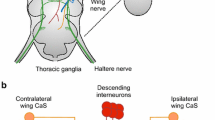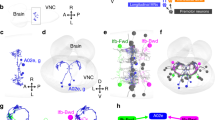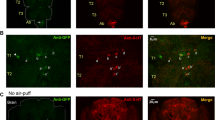Summary
-
1.
Action potentials were recorded from units of the indirect power flight muscles dvm1 and dlm of tethered flying crane flies (Tipula paludosa). The normal wingbeat frequencies of the animals were in the range of about 50 to 60 Hz. By mutilating or loading the wings the wingbeat frequencies could be adjusted to any values between 25 Hz and 160 Hz.
-
2.
There is a strong tendency for the action potentials to be phase-locked with respect to the wingbeat period at all wingbeat frequencies up to about 120 Hz (Figs. 4, 5). This holds true in spite of the fact that the action potentials do not occur in every wingbeat period (Fig. 6). Thus, wingbeat synchronous afferences influence phasically (trigger) the production of spikes in the output systems. -The dvm1-units and the dlm-units fire at different phase bands within the wingbeat period.
-
3.
If both wing nerve afferences are disrupted then in most cases only very short flights can be initiated. It can be concluded that these afferences are involved in the maintenance of flight. Prolonged flights can be elicited only exceptionally. In all cases, however, the tendency of the spikes to accumulate at small phase bands within the wingbeat cycle is drastically reduced (Fig. 8). Thus, wingbeat synchronous afferences travelling along the wing nerves contain important timing cues for the production of the neuromotor output.
-
4.
In the absence of wing nerve afferences the motor output systems supplying the flight muscle units of the dvml and the dlm, respectively, fire with their own inherent rhythm; the occurrences of spikes in the dlm are strongly correlated with the occurrences of spikes in the dvm1 and vice versa (Figs. 11B, 12). This demonstrates the existence of a central nervous mechanism which is able to produce a rhythmic motor output autonomously. -Under physiological conditions, however, the endogenous rhythm is overridden by timing cues from wingbeat synchronous afferences.
-
5.
The neural output driving the indirect flight muscles inTipula is compared with the neural output supplying the flight muscles in “higher” Diptera on the one hand and in locusts on the other. It is suggested that the tipulid flight motor system represents an early stage in the evolution of the highly specialized systems of the “higher” Diptera. -Some features of the flight motor in Diptera are summarized in a block diagram (Fig. 13).
Similar content being viewed by others
Abbreviations
- dvm :
-
dorsoventral muscle
- dlm :
-
dorsal longitudinal muscle
References
Bastian, J., Esch, H.: The nervous control of indirect flight muscles of the honey bee. Z. Vergl. Physiol.67, 307–324 (1970)
Buddenbrock, W. von: Die vermutliche Lösung der Halterenfrage. Pflügers Arch.175, 125–164 (1919)
Burrows, M.: Monosynaptic connexions between wing stretch receptors and flight motoneurones of the locust. J. Exp. Biol.62, 189–219 (1975)
Burrows, M.: Neural control of flight in the locust. In: Neural control of locomotion. Herman, R.M., Grillner, S., Stein, P.S.G., Stuart, D.G. (eds.), pp. 419–438, New York, London: Plenum Press 1976
Ewing, A.W.: The neuromuscular basis of courtship song inDrosophila: The role of the direct and axillary wing muscles. J. Comp. Physiol.130, 87–93 (1979)
Fudalewicz-Niemczyk, W.: L'innervation et les organes sensoriels des ailes des Dipteres et comparaison avec l'innervation des ailes d'insectes d'autres ordres. Acta Zool. Cracov.8, 351–462 (1963)
Harcombe, E.S., Wyman, R.J.: Output pattern generation byDrosophila flight motoneurons. J. Neurophysiol.40, 1066–1077 (1977)
Harcombe, E.S., Wyman, R.J.: The cyclically repetitive firing sequences of identifiedDrosophila flight motoneurons. J. Comp. Physiol.123, 271–279 (1978)
Heide, G.: Flugsteuerung durch nicht-fibrilläre Flugmuskeln bei der SchmeißfliegeCalliphora. Z. Vergl. Physiol.59, 456–460 (1968)
Heide, G.: Die Funktion der nicht-fibrillären Flugmuskeln vonCalliphora. II. Muskuläre Mechanismen der Flugsteuerung und ihre nervöse Kontrolle. Zool. Jb. Physiol.76, 99–137 (1971)
Heide, G.: The influence of wingbeat synchronous feedback on the motor output systems in flies. Z. Naturforsch.29c, 739–744 (1974)
Heide, G.: Properties of a motor output system involved in the optomotor response in flies. Biol. Cybernetics20, 99–112 (1975)
Heide, G.: Proprioceptorische Beeinflussung der Impulsmusterbildung im neuromotorischen System fliegender Dipteren. Verh. Dtsch. Zool. Ges.1978, 256 (1978)
Holst, E. von: Studien über Reflexe und Rhythmen beim Goldfisch (Carassius auratus). Z. Vergl. Physiol.20, 582–599 (1931)
Kristan, W.B. jr.: Neural control of swimming in the leech. Am. Zoologist14, 991–1001 (1974)
Mickoleit, W.: Die Thoraxmuskulatur vonTipula vernalis Meigen. Ein Beitrag zur vergleichenden Anatomie des Dipterenthorax. Zool. Jb. Anat.80, 213–244 (1962)
Möhl, B., Nachtigall, W.: Proprioceptive input on the flight motor revealed by muscle stimulation. J. Comp. Physiol.128, 57–65 (1978)
Moore, G.P., Perkel, D.H., Segundo, J.P.: Statistical analysis and functional interpretation of neuronal spike data. Ann. Rev. Physiol.28, 493–522 (1966)
Pearson, K.G., Iles, J.F.: Nervous mechanisms underlying intersegmental co-ordination of leg movements during walking in the cockroach. J. Exp. Biol.58, 725–744 (1973)
Pringle, J.W.S.: The gyroscopic mechanism of the halteres of Diptera. Phil. Trans. R. Soc. London B233, 347–384 (1948)
Pringle, J.W.S.: The contractile mechanism of insect fibrillar muscle. Prog. Biophys. Mol. Biol.17, 1–60 (1967)
Schneider, G.: Die Halteren der Schmeißfliege (Calliphora) als Sinnesorgane und als mechanische Flugstabilisatoren. Z. Vergl. Physiol.35, 416–458 (1953)
Sotavalta, O.: The essential factor regulating the wingstroke frequency of insects in wing mutilation and loading experiments and in experiments at subatmospheric pressure. Ann. Zool. Soc. (Zool. Bot.) Fenn. Vanamo15, 1–67 (1952)
Tiegs, O.W.: The flight muscles of insects. Their anatomy and histology; with some observations on the structure of striated muscle in general. Phil. Trans. R. Soc. London B238, 221–348 (1955)
Weis-Fogh, T.: Biology and physics of locust flight. IV. Notes on sensory mechanisms in locust flight. Phil. Trans. R. Soc. London B239, 553–584 (1956)
Wendler, G.: Einfluß erzwungener Flügelbewegungen auf das motorische Flugmuster von Heuschrecken. Naturwissenschaften59, 220 (1972)
Wendler, G.: The influence of proprioceptive feedback on locust flight co-ordination. J. Comp. Physiol.88, 173–200 (1974)
Wendler, G.: The possible role of fast wing reflexes in locust flight. Naturwissenschaften65, 65 (1978a)
Wendler, G.: Lokomotion: das Ergebnis zentralperipherer Interaktion. Verh. Dtsch. Zool. Ges.1978, 80–96 (1978b)
Wilson, D.M.: The central nervous control of flight in a locust. J. Exp. Biol.38, 471–490 (1961)
Wilson, D.M., Wyman, R.J.: Phasically unpatterned nervous control of dipteran flight. J. Insect Physiol.9, 859–865 (1963)
Wyman, R.J.: Probabilistic characterization of simultaneous nerve impulse sequences controlling dipteran flight. Biophys. J.5, 447–471 (1965)
Wyman, R.J.: Lateral inhibition in a motor output system. I. Reciprocal inhibition in dipteran flight motor system. J. Neurophysiol.32, 297–306 (1969)
Wyman, R.J.: A simple network for the study of neurogenetics. In: Simple networks and behavior. Fentress, J.C. (ed.), pp. 153–166. Sunderland, Mass.: Sinauer 1976
Zäcwilichowski, J.: Über die Innervierung und die Sinnesorgane des Flügels der SchnakeTipula paludosa Meig. Bull. Acad. Polon. Sci. — B Sci. Nat.1934, 375–384 (1934)
Author information
Authors and Affiliations
Additional information
I wish to thank Prof. K.G. Götz, Prof. F. Huber, Prof. G. Schneider and Dipl. Biol. M. Spüler for their critical readings of the manuscript. Dr. G. Mickoleit kindly identified the fly species. I am particularly indebted to Mr. H. Mikoleit, Mrs. H. Horn and Mrs. U. Unbehaun who helped in the preparation of the figures and of the manuscript and to Miss Berry for suggestions on the improvement of the English.
Rights and permissions
About this article
Cite this article
Heide, G. Proprioceptive feedback dominates the central oscillator in the patterning of the flight motoneuron output inTipula (Diptera). J. Comp. Physiol. 134, 177–189 (1979). https://doi.org/10.1007/BF00610477
Accepted:
Issue Date:
DOI: https://doi.org/10.1007/BF00610477




